- Calls to this hotline are currently being directed to Within Health or Eating Disorder Solutions
- Representatives are standing by 24/7 to help answer your questions
- All calls are confidential and HIPAA compliant
- There is no obligation or cost to call
- Eating Disorder Hope does not receive any commissions or fees dependent upon which provider you select
- Additional treatment providers are located on our directory or samhsa.gov
Eating Disorder Demographic Statistics
Eating disorder statistics, studies, and research are surprisingly difficult to find. Occasionally you will find websites and articles that reference a few key studies, but they are few and far between outside of university or clinical journals and papers. We’ve put together some of the key statistics on eating disorders here for our readers.
Anorexia Nervosa Statistics
Anorexia Prevalence
- It is estimated that 1.0% to 4.2% of women have suffered from anorexia in their lifetime.[1]
Anorexia Mortality Rates
- Anorexia has the highest fatality rate of any mental illness.[2]
- It is estimated that 4% of anorexic individuals die from complications of the disease[3]
Access to Anorexia Treatment
- Only one third of individuals struggling with anorexia nervosa in the United States obtain treatment.[4]
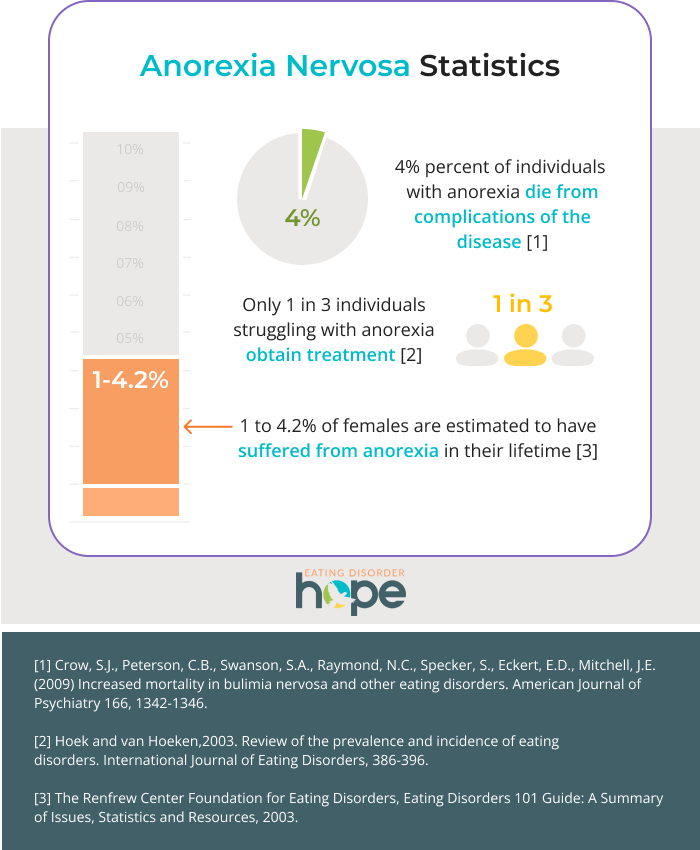
Bulimia Nervosa Statistics
Bulimia Prevalence
- It is estimated that up to 4% of females in the United States will have bulimia during their lifetime[5].
Bulimia Mortality Rates
- 3.9% of these bulimic individuals will die.[ 6]
Access to Bulimia Treatment
- Of those practicing bulimia, only 6% obtain treatment[7].
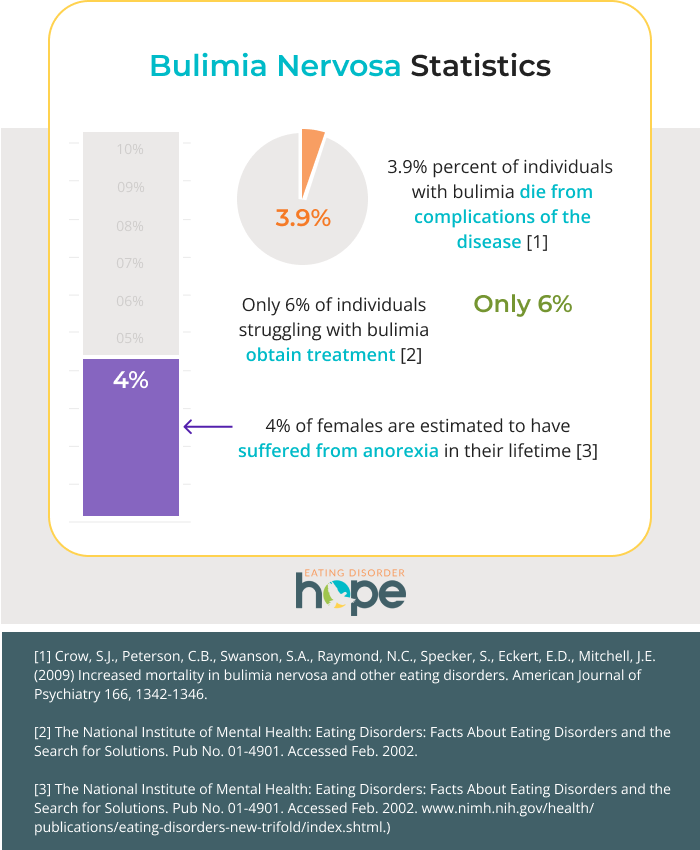
Binge Eating Disorder Statistics
Binge Eating Prevalence
- 2.8 % of American adults will struggle with BED during their lifetime. Close to 43% of individuals suffering from Binge Eating Disorder will obtain treatment[8].
Binge Eating Disorder Mortality Rates
- 5.2% of individuals suffering from eating disorders not otherwise specified,[9] the former diagnosis that BED, among other forms of disordered eating) was included in under the DSM-IV) die from health complications.
Access to Binge Eating Treatment
- Close to 43% of individuals suffering from Binge Eating Disorder will obtain treatment.[10]
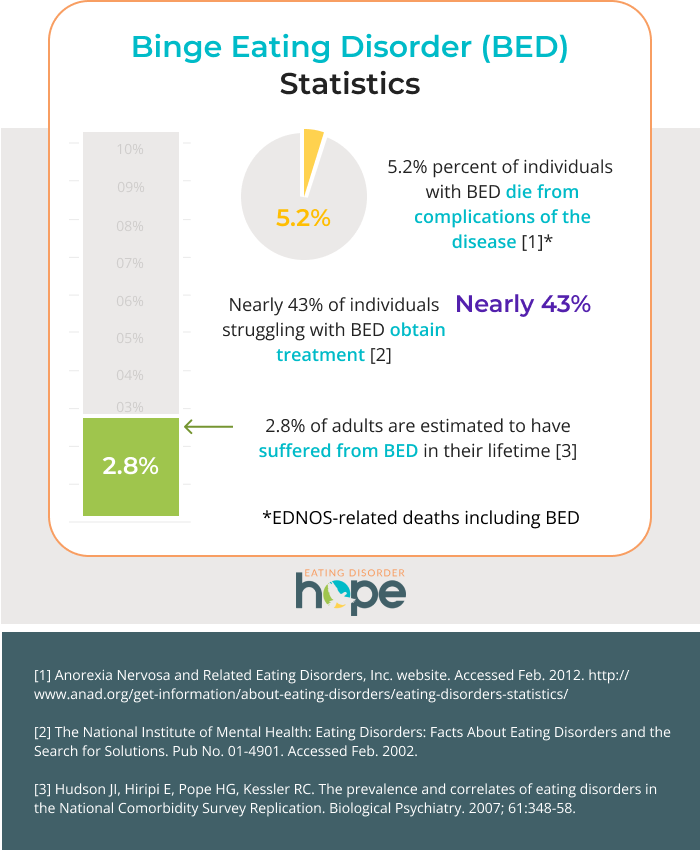
General Statistics on Eating Disorders
Society is learning that gender does not exist on a binary, however, much of the research on eating disorders and gender has been conducted based on a binary perspective of gender. As such, this section will share the current research on eating disorder prevalence in binary genders of “male” and “female” with the understanding that there is a great deal of nuance to gender that current and future research will, hopefully, soon begin to shed light on:
- Eating disorders are a daily struggle for 10 million females and 1 million males in the United States.[11]
- Four out of ten individuals have either personally experienced an eating disorder or know someone who has.[12]
Over a lifetime, the following percentages of women and men will experience an eating disorder:
Female Eating Disorder Prevalence Rates
- .9% of women will struggle with anorexia in their lifetime
- 1.5% of women will struggle with bulimia in their lifetime
- 3.5% of women will struggle with binge eating
Male Eating Disorder Statistics
- .3% of men will struggle with anorexia
- .5% of men will struggle with bulimia
- 2% of men will struggle with binge eating disorder [13]
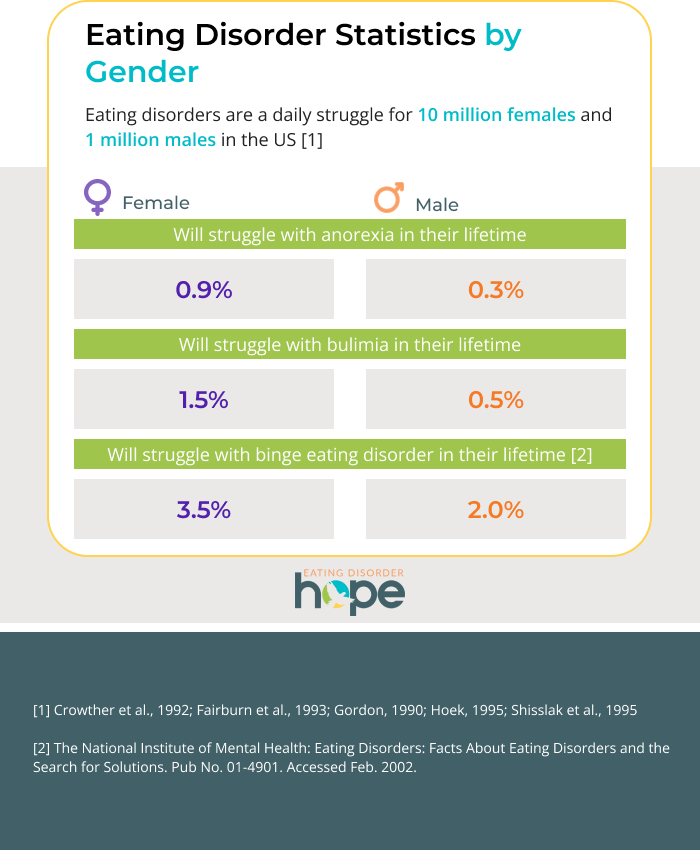
Prevalence Rates of Eating Disorders in Adolescents
Adolescents are at a concerning high risk for development of eating disorders. One overarching factor that contributes to this are the beliefs being taught to children, teens, and young adults. These beliefs often tie worth, value, happiness, and success with body weight, shape, size, and appearance and are inescapable for youth, popping up on their TVs, social media, in their schools, at home, and out in the world. In addition to the messaging surrounding appearance, weight, food, exercise, and value, today’s adolescent population are experiencing high levels of emotional distress through social upheaval, gun violence in schools, and the COVID-19 pandemic, to name just a few stressors. This has impacted adolescent development of mental illness, eating disorders included. Here is what we know:
- 2.7% of adolescents ages 13-18 years old will experience an eating disorder in their lifetime [14].
- 2.4% of those ages 13-14 will struggle with an eating disorder [23].
- 2.8% of teens ages 15-16 will struggle with an eating disorder [23].
- Increasing further, 3% of those ages 17-18 will experience an eating disorder [23].
- 8% of 15 year old girls dieted at a severe level and a further 60% dieted at a moderate level [24].
- Female adolescents “who dieted at a severe level were 18 times more likely to develop a new eating disorder within 6 months than those who did not diet, and over 12 months had an almost 1 in 5 chance of developing a new eating disorder [24].”
- Eating disorders are more than twice as prevalent male adolescents (1.5%) than female adolescents (3.8%) [23].
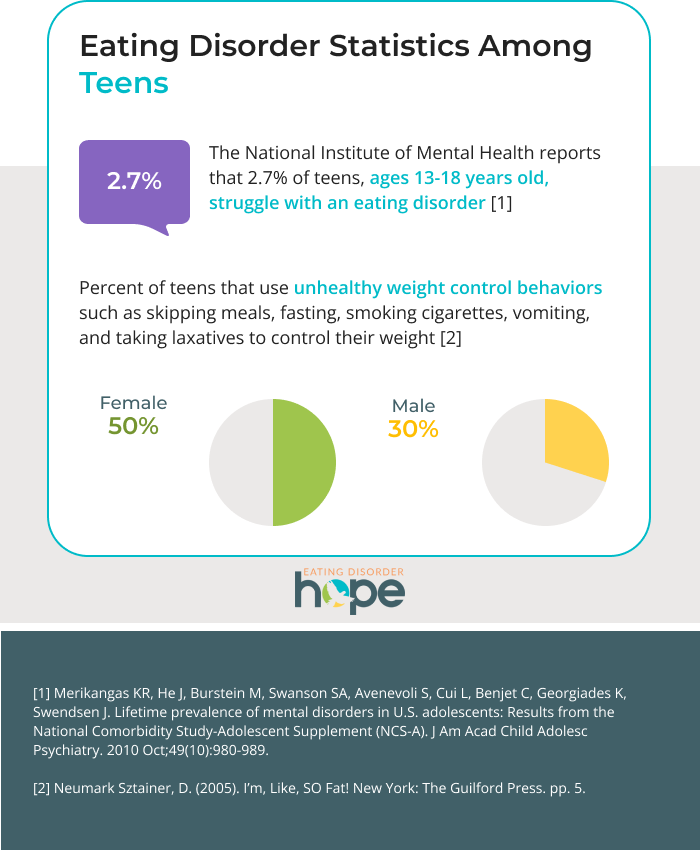
Student Eating Disorder Statistics
- 50% of teenage girls and 30% of teenage boys use unhealthy weight control behaviors such as skipping meals, fasting, smoking cigarettes, vomiting, and taking laxatives to control their weight.[15]
- 25% of college-aged women engage in bingeing and purging as a method of managing their weight.[16]

Prevalence of eating disorders among athletes
Athletes are also uniquely vulnerable to eating disorder development due to the nature that nourishment and movement have with success in their sport. One study identified several factors that make athletes susceptible to eating disorder development: “endurance, weight category…the revealing nature of much sports clothing, the intense competitiveness of sports participants which can extend to ‘competitive thinness’, specializing in one sport at an early age and sudden increases in training volume [25].” Below is more information on athletes and eating disorder development:
- Up to 84% of college athletes have at one time engaged in disordered patterns of eating or weight control behavior [35]
- 13.5% of athletes have sub-clinical to clinical eating disorders[22]
- 42% of female athletes competing in aesthetic sports demonstrated eating disordered behaviors[16]
- Approximately 45% of female athletes, and 19% of male athletes, struggle with an eating disorder [27].
- Among high school students, rates of eating disorders among athletes is higher than non-athletes, with 7.3% of athletes affected compared to 2.3% of non-athletes [28].
- 2% of female athletes struggle with anorexia nervosa [25].
- 6% of female, and 2% of male, athletes will struggle with bulimia nervosa behaviors [25].
Models with Eating Disorders Statistics
Individuals that work in the modeling industry also experience unique risk factors for eating disorders. One of the key risk factors is that, while the attachment of appearance to success is untrue for most of the population, models’ appearance is directly linked to their success in their career. Further, their ability to align physically with unrealistic social ideals of beauty is tied to their career success. This puts a great deal of pressure on these individuals to achieve what is not possible. This stress can also lead to increased mental health issues such as anxiety and depression. Further, models are at increased likelihood for assault and sexual victimization, which can lead to PTSD, a mental illness also associated closely with eating disorder development. Research has learned the following about models and eating disorders:
- An estimated 40% of models engage in disordered eating, although the experts believe this number to be much higher [29].
- 62% of models polled by The Model Alliance reported they were asked to lose weight or change their shape or size by their agency or someone else in the industry [30].
- 54% of models report skipping meals [10].
- 25% of models report using self-induced vomiting behaviors [30].
- Eighty-one percent of models reported having a Body Mass Index (BMI) classified as underweight, and many said they faced significant pressure from modeling agencies to lose weight [30].
- 54% of models were told to lose weight and that they would not book jobs if they didn’t [30].
- 21% of models were told by their agency that they would stop representing them unless they lost weight [30].
- Over 9% of models had been recommended to have plastic surgery [30].
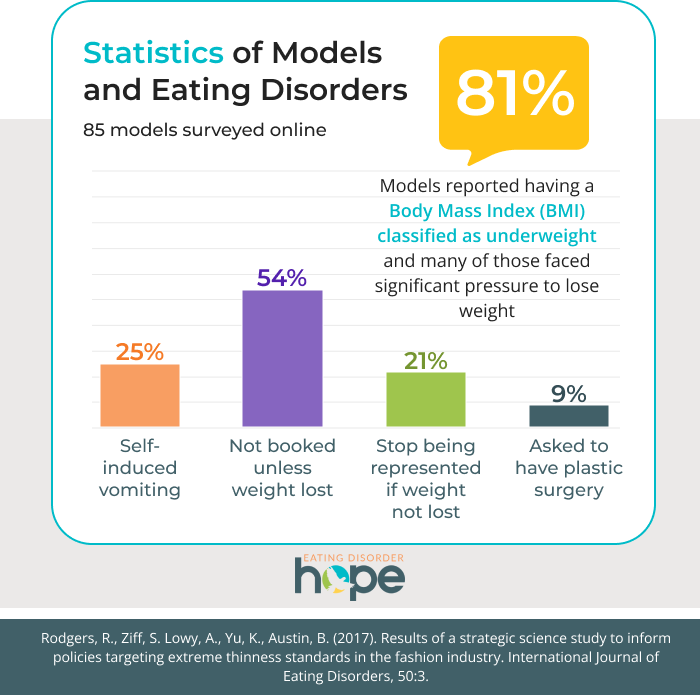
Dieting Statistics and Prevalence
- Over 50% of teenage girls and 33% of teenage boys are using restrictive measures to lose weight at any given time.[17]
- 46% of 9-11 year-olds are sometimes, or very often, on diets, and 82% of their families are sometimes, or very often, on diets).[18]
- 91% of women recently surveyed on a college campus had attempted to control their weight through dieting, 22% dieted often or always.[19]
- 95% of all dieters will regain their lost weight in 1-5 years.[20]
- 35% of normal dieters progress to pathological dieting. Of those, 20-25% progress to partial or full-syndrome eating disorders.
- 25% of American men and 45% of American women are on a diet on any given day.[21]

If you need treatment, find an eating disorder center and talk to a professional.
Exploring the prevalence of eating disorders and how this changes from population to population can help in understanding eating disorder development and developing effective eating disorder treatments.
Related Reading
- Weight and Body Image
- Addictions & Eating Disorders
- Statistics on Eating Disorders
- Eating Disorder Research & Tests
- Eating Disorders in Men
- What is Too Skinny
- What to Know About BMI
- Eating Disorders General Symptoms
- Testing for an Eating Disorder
- Eating Disorders Causes
Statistics of Eating Disorders due to Media
Media is more prevalent and easily accessible for kids and teens than ever. Adolescents are constantly being inundated with messages on how they should look, what they should be doing, what possessions they have to have, and who they should become in order to be happy, valuable, and “enough.” It is no wonder that teens are internalizing harmful ideas that their body weight, shape, size, and appearance is linked to how much they matter and, therefore, prioritize these things above all else. With advertisements, TV shows, video content, and personal accounts sending these messages constantly and teens spending an average of 6 to 7 hours per day consuming various media combined, eating disorder beliefs are flourishing [31].
Beyond the beliefs espoused themselves that send a tangential message that “appearance = worth” are the more sinister media accounts that directly teach children and teens how to engage in disordered eating and exercise behaviors. These accounts and forums present eating disorder behaviors as something to be “proud” of and are dangerous and predatory.
Research has learned the following about the relationship between media, body image, and eating disorders:
- In one study, teen’s “body image was significantly more negative after viewing thin media images than after viewing images of either average size models, plus size models or inanimate objects [11].” This effect was also found to be stronger in women younger than 19-years-old [31].
- There is “a positive association between exposure to beauty and fashion magazines and an increased level of weight concerns or eating disorder symptoms in girls [31].”
- “The importance of thinness and trying to look like women on television, in movies or in magazines were predictive of young girls (9 to 14 years old) beginning to purge at least monthly [31].”
- “Both boys and girls (aged 9 to 14 years old) who were making an effort to look like the figures in the media, were more likely than their peers to develop weight concerns and become constant dieters [31].”
- One study found that subjects reported “an interest in weight loss as a means of modelling themselves after television characters [31].”
- Another study learned that “media exposure predicted disordered eating symptomatology, drive for thinness, body dissatisfaction and ineffectiveness in women, and endorsement of personal thinness and dieting in men [31].”
- “Those who frequently read fashion magazines were twice as likely to have dieted and three times as likely to have initiated an exercise program to lose weight, than infrequent readers [31].”
Eating Disorder Mortality
The impact disordered eating behaviors have on the body are severe and can lead to numerous medical health problems and, in severe and untreated cases, death. It is difficult to consider this possibility, however, knowing the statistics surrounding eating disorders and illness and mortality can help inform motivation for recovery.
- One study learned that “only 46% of patients fully recovered from AN (anorexia nervosa), a third improved with only partial or residual features of the disorder, and 20% remained chronically ill for the long term [32].”
- “A low body mass index (BMI), a greater severity of social and psychological problems, self-induced vomiting, and purgative abuse have been identified as predictors of poor outcome in this disorder [32].”
- “The ratio of observed to expected deaths…for AN has been reported to be between 0.71 and 12.8 [32].”
- Suicide is a common cause of death for individuals struggling with anorexia nervosa [32].
- There is an “an overall elevated mortality rate for patients with all types of eating disorders” with the highest risk of death being those with anorexia [32].
Recovery from Eating Disorders – Statistics & Facts
Despite the bleak facts above, the important truth to cling to is that people recover from eating disorders and live fulfilling lives every day. While recovery is a challenging road, and will never be linear, it is absolutely possible to achieve.
- Among the 21% of individuals that experience “full recovery,” 94% continued to maintain that recovery 2 years after treatment [33].
- 50% of patients with anorexia nervosa make a “full recovery [33].”
- Studies show that, despite initial follow-up results indicating low rates of recovery, “continued symptom improvement and meaningful recovery are possible in anorexia nervosa beyond the first decade of follow-up [34].”
References
- The Renfrew Center Foundation for Eating Disorders, Eating Disorders 101 Guide: A Summary of Issues, Statistics and Resources, 2003.
- Sullivan, P. (1995). American Journal of Psychiatry, 152 (7), 10731074.
- Crow, S.J., Peterson, C.B., Swanson, S.A., Raymond, N.C., Specker, S., Eckert, E.D., Mitchell, J.E. (2009) Increased mortality in bulimia nervosa and other eating disorders. American Journal of Psychiatry 166, 1342-1346.
- Hoek and van Hoeken,2003. Review of the prevalence and incidence of eating disorders. International Journal of Eating Disorders, 386-396.
- The National Institute of Mental Health: Eating Disorders: Facts About Eating Disorders and the Search for Solutions. Pub No. 01-4901. Accessed Feb. 2002. www.nimh.nih.gov/health/publications/eating-disorders-new-trifold/index.shtml.)
- Crow, S.J., Peterson, C.B., Swanson, S.A., Raymond, N.C., Specker, S., Eckert, E.D., Mitchell, J.E. (2009) Increased mortality in bulimia nervosa and other eating disorders. American Journal of Psychiatry 166, 1342-1346.
- The National Institute of Mental Health: Eating Disorders: Facts About Eating Disorders and the Search for Solutions. Pub No. 01-4901. Accessed Feb. 2002. www.nimh.nih.gov/health/publications/eating-disorders-new-trifold/index.shtml.)
- Hudson JI, Hiripi E, Pope HG, Kessler RC. The prevalence and correlates of eating disorders in the National Comorbidity Survey Replication. Biological Psychiatry. 2007; 61:348-58.
- Anorexia Nervosa and Related Eating Disorders, Inc. website. Accessed Feb. 2012. http://www.anad.org/get-information/about-eating-disorders/eating-disorders-statistics/
- The National Institute of Mental Health: Eating Disorders: Facts About Eating Disorders and the Search for Solutions. Pub No. 01-4901. Accessed Feb. 2002. www.nimh.nih.gov/health/publications/eating-disorders-new-trifold/index.shtml.)
- Crowther et al., 1992; Fairburn et al., 1993; Gordon, 1990; Hoek, 1995; Shisslak et al., 1995
- Global Market Insite Study @ NEDA, 2005
- The National Institute of Mental Health: Eating Disorders: Facts About Eating Disorders and the Search for Solutions. Pub No. 01-4901. Accessed Feb. 2002. www.nimh.nih.gov/health/publications/eating-disorders-new-trifold/index.shtml.)
- Merikangas KR, He J, Burstein M, Swanson SA, Avenevoli S, Cui L, Benjet C, Georgiades K, Swendsen J. Lifetime prevalence of mental disorders in U.S. adolescents: Results from the National Comorbidity Study-Adolescent Supplement (NCS-A). J Am Acad Child Adolesc Psychiatry. 2010 Oct;49(10):980-989.
- Neumark Sztainer, D. (2005). I’m, Like, SO Fat! New York: The Guilford Press. pp. 5.
- The Renfrew Center Foundation for Eating Disorders, Eating Disorders 101 Guide: A Summary of Issues, Statistics and Resources, 2003.
- Neumark Sztainer, D. (2005). I’m, Like, SO Fat! New York: The Guilford Press. pp. 5.
- Gustafson-Larson, A.M., & Terry, R.D. (1992). Weight-related behaviors and concerns of fourth-grade children. Journal of American Dietetic Association, 818-822.
- National Eating Disorders Association website. Statistics: Eating Disorders and Their Precursors. Accessed feb.2012 http://www.nationaleatingdisorders.org/uploads/statistics_tmp.pdf
- Grodstein, F., Levine, R., Spencer, T., Colditz, G.A., Stampfer, M. J. (1996). Three year follow up of participants in a commercial weight loss program: can you keep it off? Archives of Internal Medicine. 156 (12),1302.
- Shisslak, C.M., Crago, M., & Estes, L.S. (1995). The spectrum of eating disturbances. International Journal of Eating Disorders, 18 (3), 209219.
- Sundgot-Borgen J, Torstveit MK. (2004). Prevalence of eating disorders in elite athletes is higher than in the general population. Clin J Sport Med., Jan;14(1):25-32.
- Unknown (2021). Eating disorders. National Institute of Mental Health. Retrieved from https://www.nimh.nih.gov/health/statistics/eating-disorders#part_2571.
- Patton, G. C. et al. (1999). Onset of adolescent eating disorders: population based cohort study over 3 years. BMJ.
- Currie, A. (2010). Sports and eating disorders – understanding and managing the risks.Asian Journal of Sports Medicine, 1:2.
- Ghoch, M. E., et al. (2013). Eating disorders, physical fitness, and sport performance: a systematic review. Nutrients, 5:12.
- Bratland-Sanda S, Sundgot-Borgen J. Eating disorders in athletes: overview of prevalence, risk factors and recommendations for prevention and treatment. Eur J Sport Sci. 2013;13(5):499-508. doi: 10.1080/17461391.2012.740504. Epub 2012 Nov 13. PMID: 24050467.
- Conviser, J. H., Schlitzer Tierney, A., Nickols, R. (2018). Assessment of Athletes with eating disorders: essentials for best practice. Journal of Clinical Sports Psychology, 12.
- Nordqvist, C. (2008). Eating disorders among fashion models on the rise. Medical News Today. Retrieved from https://www.medicalnewstoday.com/articles/76241#1.
- Rodgers, R., Ziff, S. Lowy, A., Yu, K., Austin, B. (2017). Results of a strategic science study to inform policies targeting extreme thinness standards in the fashion industry. International Journal of Eating Disorders, 50:3.
- Morris, A. M., Katzman, D. K. (2003). The impact of media on eating disorders in children and adolescents. Pediatrics & Child Health, 8:5.
- Arcelus, J., Mitchell, A. J., Wales, J. (2011). Mortality rates in patients with anorexia nervosa and other eating disorders. Archives of General Psychiatry, 68:7.
- Leigh, S. (2019). Many patients with anorexia nervosa get better, but complete recovery elusive to most. University of California San Franciso. Retrieved from https://www.ucsf.edu/news/2019/11/416006/many-patients-anorexia-nervosa-get-better-complete-recovery-elusive-most.
- Eddy, K. T., et al. (2017). Recovery from anorexia nervosa and bulimia nervosa at 22-year follow-up. Journal of Clinical Psychiatry, 78:2.
- Power, K., Kovacs, S., Butcher-Poffley, L., Wu, Jingwei, and Sarwer, D. (n.d.). Disordered Eating and Compulsive Exercise in College Athletes: Applications for Sport and Research. The Sport Journal 22.
Author: Margot Rittenhouse, MS, LPC, NCC
Page Last Reviewed and Updated by Jacquelyn Ekern, MS, LPC 3.1.22

